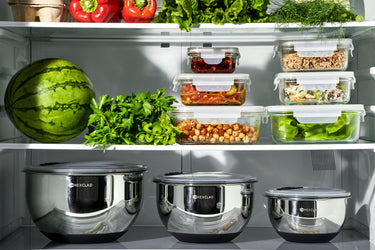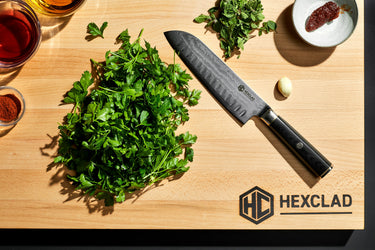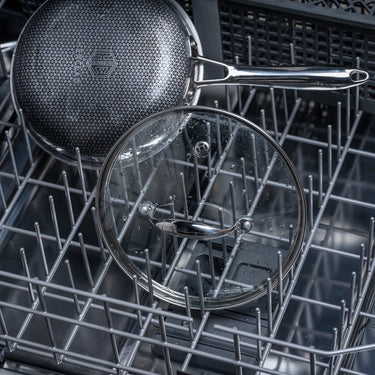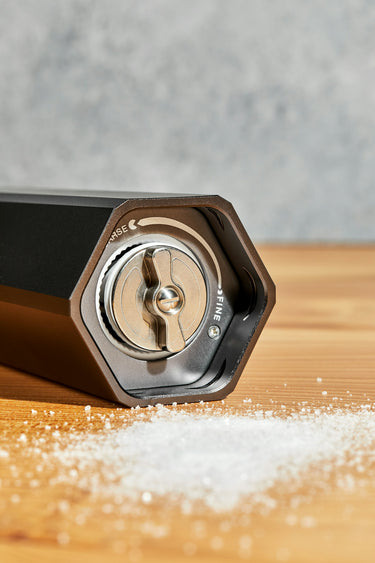How To Care for Your Knives: Honing vs. Sharpening
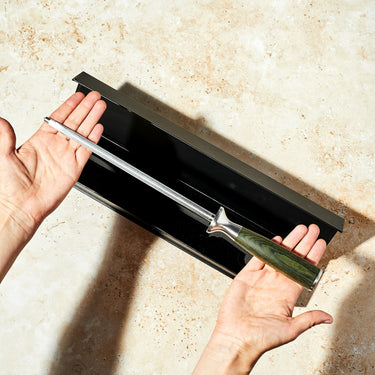
Whether you are a professional chef or an avid foodie, one of the essential tools for cooking is your knife. However, due to the major role a knife plays in the kitchen, the blade becomes dull over time, and its performance might not cut as effectively as it used to.
You can increase your knife’s performance and the blade in two ways: by honing and sharpening it. Sharpening your knives improves the quality, and honing supports the cutting edge. This increases your knife's efficiency and lifespan, reducing the risk of potential accidents and mistakes.
Sharpening and honing are often confused due to their physical similarities. However, it’s essential to note that sharpening your knives and honing them are entirely different actions.
Although they have different abilities, honing and sharpening are vital in maintaining your knife. If you are interested in getting the best out of this kitchen utensil but are having trouble figuring out the difference between honing and sharpening, don’t worry.
Here, we will go over the similarities and differences between the two, how each works, and why it’s crucial to do both at the appropriate times.
What Materials Are Used for Kitchen Knife Blades?
Now before you consider honing and sharpening your knives, you need to be aware of the type of cutlery you have. How you implement these maintenance processes depends on the material of the blade itself.
Carbon Steel
Carbon steel is one of the primary materials for knives. One of the advantages to having a carbon steel knife is that it keeps its sharp edge for a while. You rarely have to worry about seeking professional help. You can hone and sharpen these blades at home. Although carbon steel keeps its edge, it does require more upkeep.
Stainless Steel
Stainless Steel is another reasonably popular material for knives. This is a more wallet-friendly option to select. It doesn’t require high maintenance either. For this type of knife, you should consider honing and sharpening it to keep its blade sharp and ready for action.
Ceramic
Ceramic is pretty standard if you want a knife that keeps its edge and doesn’t require high maintenance. Another beneficial factor of ceramic is that it’s lightweight. You can handle the blade quickly without tiring your hand.
What Are the Main Types of Kitchen Knives?
When sharpening and honing, figure out what type of knife you own. The types of knives include the following:
- Chef’s Knife: This is a long, broad knife that can be used for meats, vegetables, and other food.
- Serrated Knife: This is usually used as a bread knife or for meat and vegetables.
- Paring Knife: This type of knife is primarily used for peeling, trimming, and cutting up fruits and vegetables. However, it’s also used for cutting up hard meat as well.
What Is Knife Honing?
When it comes to knife honing, it usually refers to realigning your blade so it can cut efficiently. Honing is often mistaken for sharpening is due to the honing utensil used in the process.
A honing rod is what you use for your knife, but it does not sharpen your knife as a sharpening rod would do. The physical attribute of a honing rod is a rounded stick, usually made from ceramic, stainless, or carbon steel.
How Do You Hone a Knife?
There are multiple ways that you can hone a knife. Believe it or not, several methods don’t even use a honing rod. Below, we will provide a tutorial on honing steel knives — all you need is a dull kitchen knife and a honing rod.
Angle Your Honing Rod and Kitchen Knife
The first step in honing your kitchen knife is to angle your rod correctly against the knife. Place the honing knife vertically against your cutting board, holding it with your non-dominant hand and the kitchen knife in your dominant one. Place the heel of the blade at the top against the honing rod at a 20-degree angle.
It’s important to note that angling your honing rod against your kitchen knife has to be at the right angle. If you do not angle your honing rod properly, it cannot properly file your blade. If it’s too narrow, it won’t hone your knife, and if it’s too wide, it will further dull your blade.
Apply Pressure and Start Honing
Once you angle your honing rod at a 20-degree angle and place the blade’s heel at the top, apply light pressure to the knife against the rod, then slide down in a sweeping motion. Ensure that the blade’s edge is touching the rod and that it's pulling towards you. The knife should be touching the middle of the steel.
To avoid damaging the blade and potential accidents, apply gentle but firm strokes. The usual amount of strokes on each side would be three to five, but you can repeat the process if your knife’s blade isn’t correctly aligned.
Check Your Knife and Repeat
Applying three to five strokes against the honing rod on each side should be enough to align your knife.
To make sure that it cuts properly, you can always try to cut a piece of fruit. A sharp knife should cut efficiently, but if it struggles or requires more pressure, you might have to repeat the process.
Why Should You Hone Your Knives?
Honing your knife is essential because it affects how you cut your ingredients and prevents potential accidents when adequately maintained. Honing ensures that your blade is properly aligned. Repeating this process frequently eliminates the likelihood of the blade becoming dull.
Cutting with a dull blade causes you to apply more force, leading to the knife slipping off what you are cutting. Nobody needs that.
When ensuring that your kitchen knife can function efficiently by sharpening it, honing aligns your cutting edge so that it performs efficiently.
How Often Should You Hone Your Knives?
Fortunately, it’s not a requirement to hone your knives before every use. However, you should generally hone your kitchen blades every three to five uses. You don’t have to repeat this process every week, but aside from doing this at home, you should also get your knives honed professionally at least two to three times a year.
Can You Hone Your Knives at Home?
Yes! You can hone your knives at home. There are honing rods and other products that you can buy to use for your kitchen tool. We provide a versatile nine-inch honing steel rod that works efficiently with any type of blade material, including Japanese knives.
However, even though you can do this at home, it's essential to get your blade honed professionally whenever you can — ideally two to three times a year.
One of the reasons you have to take your knives to a professional is that, over time, without frequently honing, your knife may become bent or misaligned. Also, even if you do hone your knives every so often, sometimes they still won’t cut efficiently.
What Is Knife Sharpening?
While honing your knives primarily deals with realigning your blade to cut effectively, sharpening steel knives deals with restoring the knife blade to its original sharpness by removing material that may have dulled it.
While you can use a sharpening steel rod, most professional chefs and solid home cooks usually have automatic knife sharpeners, whetstones, or manual sharpeners.
How Do You Sharpen a Knife?
The primary goal is to produce a sharp edge for your kitchen knife. There are several different methods aside from using steel rods to sharpen them. Below, we will go over how to sharpen your knife using a whetstone or knife sharpener.
To sharpen your knife, you will need:
- Your dull kitchen knife
- A towel or mat
- A knife sharpener
- Whetstone
Sharpening Your Knife Using a Sharpening Stone
If you want efficient results, one solution is to sharpen your knife using a whetstone. You must place your towel or mat under your whetstone to have a firm surface to prevent slipping. Next, place your whetstone in a bowl or large dish and submerge it in water or oil.
Let the stone soak for at least 10 minutes before taking it out for use and angling it coarse side up. Similarly to honing, ensure that you have it propped up at a 20-degree angle and have the blade's edge against the rough side of the stone.
Once you have your knife against the stone, apply light pressure and slide down the coarse surface at the correct 20-degree angle. Repeat this two to six times, then do the same on the fine side of the stone to perfect the sharpness. It’s essential to use this stone when it’s damp so it doesn’t dry out. Finally, dry your whetstone and store it in a dry environment.
Sharpening Your Knife Using an Automatic Sharpener
One of the advantages of using an electric knife sharpener is that it eliminates the hassle of thorough maintenance. All you have to do is place your knife into the coarse side of the sharpener and drag it at least 10 to 12 times. Then repeat this process on the fine side, but only slide the blade two to three times.
Why Should You Sharpen Your Knives?
Compared to honing your knives, the importance of sharpening knives is to prevent a dull edge of the blade. Implementing the sharpening process for your knife lengthens the lifespan of your blade and ensures that it can cut through food without a hassle. Another benefit of sharpening your knives is that it increases precision and safety.
How Often Should You Sharpen Your Knives?
How often you should sharpen your knives depends on if they are frequently used. Even if you don’t continually sharpen your knives, you should complete this process every two months. If you don’t feel comfortable sharpening your knifes yourself, bring your knives to a professional sharpening service for an easy way to help extend their life and quality.
Can You Sharpen Your Knives at Home?
Yes! You can sharpen your knife set at home. What’s beneficial about this is that Amazon and other online stores provide sharpening tools to use for your knives, either a whetstone, electric, or manual sharpener. However, even though you can do this at home, you should consider taking your dull knives to professionals.
Every now and then, taking your blades to a professional knife sharpener every now and then strengthens your knife’s quality.
The Bottom Line
So, what is the difference between honing and sharpening your knife? Honing your knife refers to realigning your knife’s blade so that it cuts effectively. Sharpening your knife sharpens the blade.
When preventing your knife from becoming dull, it’s essential to hone and sharpen your knife regularly. For better results, seek professional guidance twice a year. What are you waiting for? Get into the kitchen and get those knives prepped!
Sources:
Why are Sharp Knives Safer than Dull Blades? | Home-Ec 101
Types of knives: A guide to kitchen knives and their uses | AllianceOnline
Be Careful with Kitchen Knives - Health Encyclopedia | University of Rochester Medical Center
The Different Types of Kitchen Knives and Their Uses | Healthy Kitchen 101
How to Sharpen A Kitchen Knife With a Whetstone (for Beginners) 🔪 | Mediocre Chef
